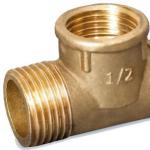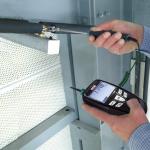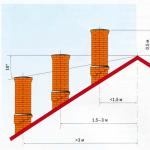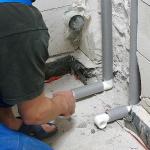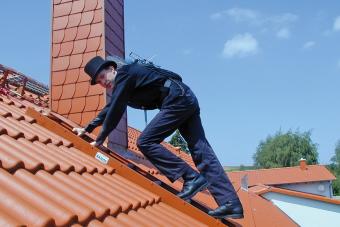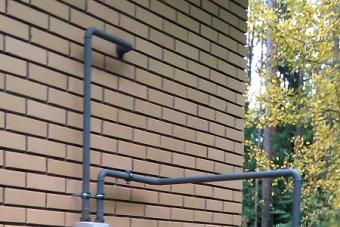Over time, a brick oven or an open-hearth fireplace becomes covered with soot. If the brick is light, then it is very noticeable and spoils the whole appearance. In addition, two or three times a year, the chimney of any kind of stove must be cleaned of soot inside the pipe. You can learn more about how to clean a brick from soot and what methods of cleaning a chimney exist.
To remove soot from the brickwork of the stove or fireplace, you can use the following methods:
- Washing with a normal damp sponge
- Vacuuming the brick surface, washing with detergents
- Using Baking Soda and Vinegar
- Special products for cleaning brick surfaces.
To clean the outer walls of the fireplace, you will need equipment: rubber gloves, a stiff brush, a broom, a vacuum cleaner, a sponge.
 How to clean brick from soot
How to clean brick from soot The floor around the fireplace is lined with a film so as not to contaminate the floor covering when cleaning. Next, you can prepare a mixture for washing bricks, which consists of salt and ordinary washing powder. The stronger the pollution and the larger the surface to be treated, the more ingredients will be needed. The finished solution should look like a thick paste. The brick is wetted with a foam sponge from top to bottom and cleaned of surface contaminants. Then the prepared solution is whipped in water until foam is formed and applied to the brick. The product should remain on the wall for at least 15-20 minutes, while the foam should turn black. After that, the solution is washed off with a brush. This method is effective in case of light pollution. Cleaning stoves from soot that has eaten into the brick can be carried out using the following methods:
- The masonry is wetted with water, then vinegar is applied to it for 20-30 minutes, after which it can be cleaned with a sponge and water. When using this method, you need to ventilate the room well.
- Using a washing vacuum cleaner after applying a solution of salt and powder to the masonry. This method is not suitable for cleaning old brickwork, as it can destroy it.
- The use of special detergents designed for cleaning brick surfaces.
How to clean the oven from soot
If you do not carry out preventive cleaning of the pipe chimney before each heating season, or even more often, this will lead to the accumulation of soot and soot up to several tens of centimeters thick inside it. This should not be allowed, since the walls of the pipe begin to wear out, the draft worsens, as a result, the chimney opening may catch fire. To avoid this, you need to know several ways how to clean the chimney of the furnace from soot. They can be divided into three groups: mechanical cleaning, chemical cleaning and the use of home remedies.
- Mechanical cleaning is suitable for removing a layer of soot with a thickness of more than 5 mm.
To do this, you will need: a special metal ruff, a small weight on a rope, hard wire brushes and a hook, as well as protective equipment for the eyes, hands and respiratory tract. To clean the fireplace, you need to do it from below, and the stove - from above.
 Chimney cleaning
Chimney cleaning It is necessary to tightly close the firebox door and other openings leading into the house. If there is debris in the chimney, you need to push it down with a long stick and remove it from the house already. The soot is brushed off with a brush and round wire brushes, and the jam is pushed through by a weight on a suspension. After that, you need to remove the soot from the cleaning holes and from the furnace.
- The chemical cleaning composition is suitable for use if the plaque has a small thickness. Before cleaning the stove from soot, the chimney must be freed from debris. Usually, the chemical method is classified as a preventive measure.
This method consists of the use of chemicals that must be burned in a stove. The most popular are:
- A mixture of the same amount of saltpeter, blue vitriol and coke, which must be poured in a maximum dosage of 200 g on smoldering coals. Causes shedding of soot.
- Flame Retardant Chemical Composition (PCC): An effective composition that is burned in the package. The maximum allowable quantity is indicated in the instructions, it must not be violated.
- Czech remedy "Cominicek": consists of copper chloride, so when using it, it is necessary to ventilate the room. Works well with light soot.
- "Chimney-sweep log", consisting of natural aspen or birch wood impregnated with copper chloride. When burned, it causes exfoliation of tar deposits.
- Home remedies.
- The most effective, but not suitable for weak chimneys, is aspen firewood. When burned, the soot inside the chimney ignites, white flakes begin to fly out. The design warms up to 1000 degrees, so it must be strong enough.
- Potato peelings will help with small deposits. They can also be used as a pre-cleaner before using the mechanical method, as they soften the soot. To do this, you need to prepare 0.5 buckets of dry cleanings or finely chopped dry potatoes, which must be thrown on smoldering coals. The released starch will soften the soot and help in the further fight against its removal.
- As a preventive measure, you can use ordinary salt: every time you kindle the stove, it must be poured onto burning firewood. After that, the soot becomes less viscous and settles on the pipe in smaller quantities.
- Naphthalene: one tablet can be thrown into a burning firebox, the effect of such cleaning is similar to aspen firewood. Before use, make sure that the integrity of the pipe outside and the absence of debris inside.
- In order to keep soot as little as possible in the chimney, you can burn one aluminum can every ten kindlings. At the same time, the temperature should be such that the jar actually burns.
- A similar method to mechanical cleaning is the use of a conventional (hard) hose, on the end of which a cut-off plastic bottle or brush is attached.
Thus, with small accumulations of soot inside the chimney, you can get by with preventive measures using home remedies. If the chimney is significantly narrowed due to a thick layer of soot, it is better to use one of the chemical methods, then clean it mechanically.
